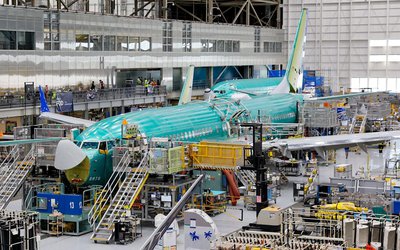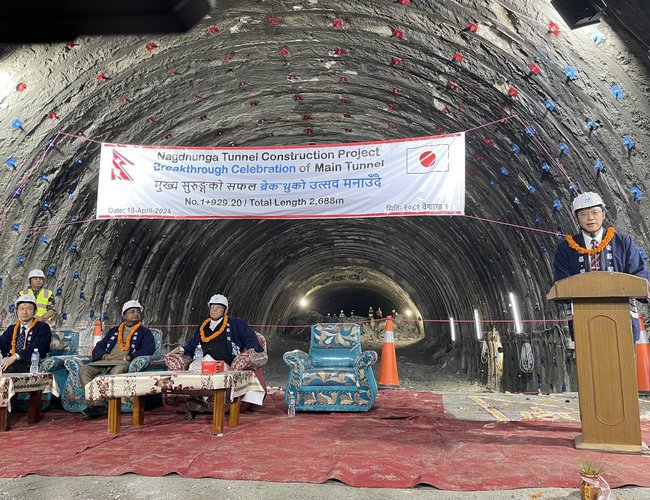
The Nepal-Japan cooperation partnership has reached a significant milestone with the completion of the Nagdhunga Main Tunnel. This tunnel, funded by Japan, will be the first of its kind to incorporate modern technology.
It is a momentous occasion for Nepal's road infrastructure, as the country has been waiting for over a century to utilize tunnels since the construction of the first road tunnel in Churia of Hetauda a hundred years ago. While some shorter tunnels have been built along the road, such as the ones in Tamakoshi and Marsyangdi, the Nagdhunga Tunnel will be the first to accommodate large vehicles and provide all modern amenities.
The final two-meter stretch of the main tunnel was cleared using explosives, marking a breakthrough in its construction. The tunnel is expected to be open to the public in approximately one year.
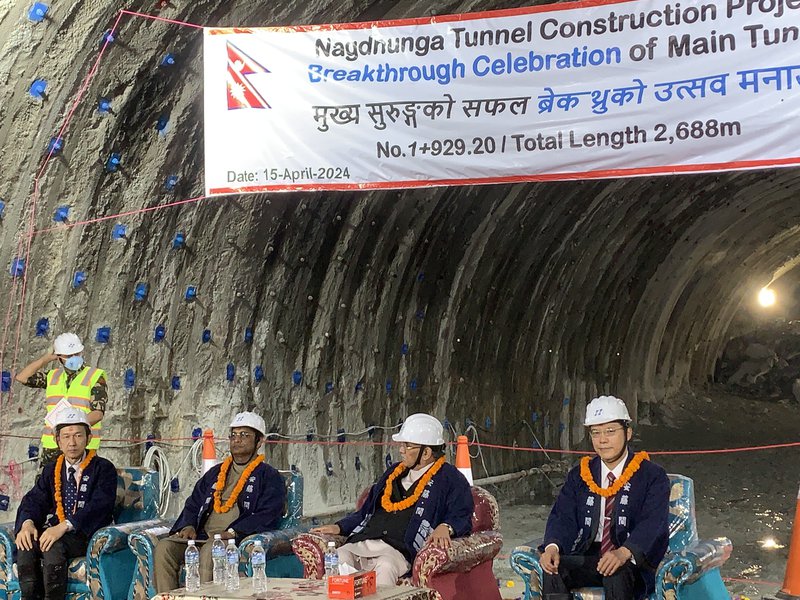
The Japan International Cooperation Agency (JICA) has played a significant role in Nepal's transportation sector development, including the Sindhuli Road project that connects Kathmandu with the eastern Terai region. JICA has also provided technical cooperation for urban transport management in Kathmandu, among other initiatives. The Nagdhunga Tunnel Construction Project is the first Japanese ODA Loan Project for Nepal's transport sector, with JICA offering a concessional loan assistance of 16.63 billion Japanese Yen.
The Loan Agreement was executed in 2016, and the commencement of construction took place in 2019. Nagdhunga Tunnel is set to become the first mountain road tunnel in the country, with the objective of enhancing the road conditions surrounding Nagdhunga pass.
This will contribute to the establishment of a seamless transportation network and promote commercial activities between Kathmandu and other key areas in Nepal. The tunnel consists of two lanes and spans a total length of 2.69 km. It is equipped with essential facilities such as an evacuation tunnel, access road with a flyover, and toll booths.
Once operational, it is anticipated to alleviate traffic congestion along the Nagdhunga-Naubise road section, while also reducing air pollution, saving travel time, and minimizing traffic accidents. Following the breakthrough, it will take approximately one more year to complete the entire construction before the tunnel can be opened for public use.
In addition to its significance in terms of infrastructure, the Nagdhunga tunnel represents a milestone in Nepali efficiency, as it marks the first time that Nepalese manpower has been employed in the construction of a highway tunnel. This project serves as an exemplary model for knowledge transfer in highway tunnel construction. Kikuta Yutaka, the Ambassador of Japan to Nepal, expressed his heartfelt anticipation of hearing many Nepali engineers in the future proudly share their experiences with Nagdhunga, as conveyed by the Japanese project manager.
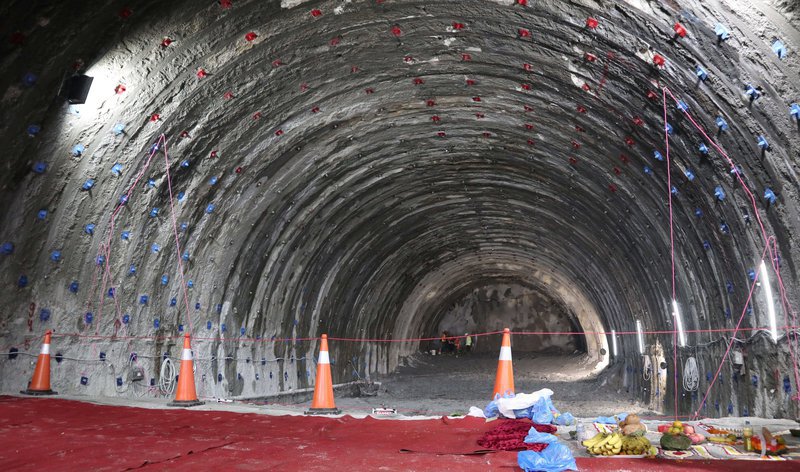
In the presence of Prime Minister Pushpa Kamal Dahal ‘Prachanda,’ Deputy Prime Minister and Minister for Physical Infrastructure and Transport Raghubir Mahaseth, Ambassador of Japan to Nepal Kikuta Yutaka, and officials from the Department of Roads, Embassy of Japan, and JICA Nepal, the breakthrough of the main tunnel was celebrated officially.
Okubo Akimitsu, Chief Representative of JICA Nepal, expressed his congratulations to the Government of Nepal, including the Ministry of Finance, the Ministry of Physical Infrastructure and Transport, and the Department of Roads, as well as the Consultant Nippon Koei and its partners, the contractor Hazama Ando Corporation, and the sub-contractors for their exceptional work, immense efforts, and dedication in achieving the successful breakthrough of the Nagdhunga Tunnel.
Pride of Country
The long-awaited breakthrough of the Nagdhunga Tunnel has finally been achieved. The excavation of the 2,688m-long main tunnel has been successfully finished. Kikuta Yutaka, Ambassador of Japan to Nepal, extended his congratulations to all those involved, both Japanese and Nepalese, for overcoming numerous challenges to reach this significant milestone, stating, "You are the pride of the country."
The Nagdhunga Tunnel is Nepal's first mountainous traffic road tunnel. Valued at Rs 22 billion, with three-quarters of the funding provided by the government of Japan through highly concessional loans to the Government of Nepal, the construction was entrusted to Japanese engineering companies, who exerted every effort for the development of Nepal.
Upon completion of the remaining interior work, such as lining and installation of equipment, traffic convenience will be greatly enhanced. This will have a profound impact on the local economy as well. The construction of the tunnel began in 2019. Excavating a tunnel in the Himalayan mountainous region, which is still rising and has complex strata, presented an incredibly challenging task.
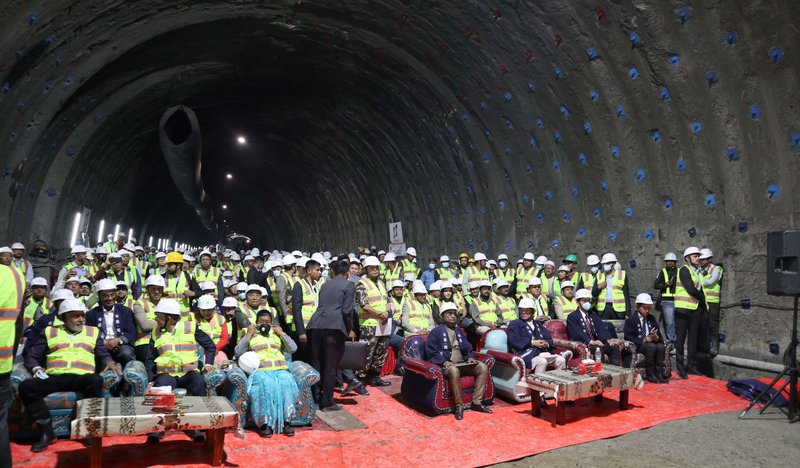
The interior of the evacuation and main tunnels faced unexpected floods and collapses repeatedly during the arduous excavation work. Outside the tunnel, heavy rainfall triggered landslides on the slope faces, while the Covid-19 pandemic further delayed progress.
The Nepalese teams have been working together with the Japanese teams to address technical obstacles on the site, drawing from their expertise gained from the construction of Sindhuli road, popularly known as BP highway, which was also backed by the Government of Japan. This endeavor presents a distinctive chance to impart advanced Japanese skills to the budding Nepalese engineers, ultimately benefiting the people of Nepal in the long run.
PM Prachanda at Inauguration
A significant number of Nepalese engineers and technicians have received training in Japan with the assistance of the Japanese government. Prime Minister Pushpa Kamal Dahal himself attended the breakthrough ceremony of the Nagdhunga Tunnel, highlighting Japan's crucial support to Nepal.
During the event, Prime Minister Pushpa Kamal Dahal emphasized that the completion of the tunnel marked a significant infrastructural milestone for Nepal, contributing to the achievement of national development and road expansion objectives. He mentioned plans to assess tunnels suitable for Nepali soil based on the Nagdhunga Tunnel, envisioning Nepal's entry into the 'tunnel age'.
Prime Minister Dahal expressed confidence that the tunnel would alleviate traffic congestion, reduce road accidents, and serve as a solution to natural disasters like landslides during the monsoon season. Deputy Prime Minister and Minister of Physical Infrastructure and Transport Raghubir Mahaseth hailed the breakthrough as a major success, pledging the government's full commitment to timely project completion. He extended gratitude to the government of Japan and JICA for their support in Nepal's infrastructure development.
The Nagdhunga-Sisnekhola tunnel connects Dhading, where the lower end is situated, to Nagdhunga in Kathmandu, the higher end.

Japan has played a significant role in transforming Nepalese society through its unique support in various sectors such as hydropower, drinking water, disaster risk management, water resources, education, earthquake, agriculture, aviation, health, and human resource development. One notable example is the Kulekhani Hydropower project, which is the only storage project in Nepal supported by Japan, ensuring a stable supply of electricity during dry seasons. Additionally, Japan International Cooperation Agency (JICA) has been a major partner in the construction of the Tanahu Hydropower project.
Another remarkable contribution is the construction of the Banepa-Sindhuli road, which has revolutionized Nepal's road sector by significantly reducing travel time for passengers from eastern Nepal. This improvement has not only facilitated transportation but also supported the commercialization of agriculture, thereby enhancing the livelihoods of the people. JICA has also provided financial support for the construction of a water treatment plant, which treats water from the Melamchi Project and supplies it to the Kathmandu Valley.
In the field of healthcare, Japan's support is evident through the establishment of the Tribhuwan University Teaching Hospital in Maharajgunj, the first medical college in Nepal. This institution has been instrumental in producing medical professionals, including doctors and specialists. Furthermore, Japan has contributed to the reconstruction of school buildings across Nepal after the devastating earthquake, including a new building for Bir Hospital.
Japan's involvement in the agriculture and horticulture sector is notable, with support provided through the implementation of the "one village one product" schemes. Additionally, Japan has helped enhance the quality of Nepal's civil services by offering JDS scholarships. Moreover, Japan has equipped Tribhuwan International Airport with modern navigation equipment, ensuring safer operations for aircraft.
Overall, Japan's unique support in various sectors has made a significant impact on the development and transformation of Nepalese society.
Upon the completion of the project, travelers on the Nagdhunga-Naubise route will have the advantage of bypassing nineteen hairpin bends and sharp curves along an 8 km stretch of the road. A 2015 preliminary study revealed that it currently takes approximately 34 minutes to traverse the 8 km section using the existing road alignment.

In 2016, the Japanese government agreed to extend a soft loan of Rs15.28 billion for the construction of a tunnel, which will eliminate the need to take the circuitous route over the western rim of the Valley. This route serves as the primary overland connection between the Capital and the southern plains.
In the words of Japanese Ambassador to Nepal, Yutaka, the assistance provided by Japan, funded by the taxes of the Japanese people, is not considered charity but rather an investment in Nepal's promising future. This sentiment is further emphasized by the label "From the People of Japan" on Japanese ODA projects. Since the establishment of diplomatic ties between Nepal and Japan, the contributions of the Japanese government have been greatly appreciated for their significant impact on Nepal's development sector.
- Japanese Film Festival And Japan Day In Kathmandu
- Apr 09, 2024
- JENESYS Friendship Ties Program: Learning From Japan
- Feb 05, 2024
- 78th Hiroshima Day: A Look Back
- Aug 08, 2023
- JDS : Japan’s Support To Nepal
- Jul 31, 2023
- Japan’s Support To Nepal: Uplifting The Economy
- Jun 29, 2023








